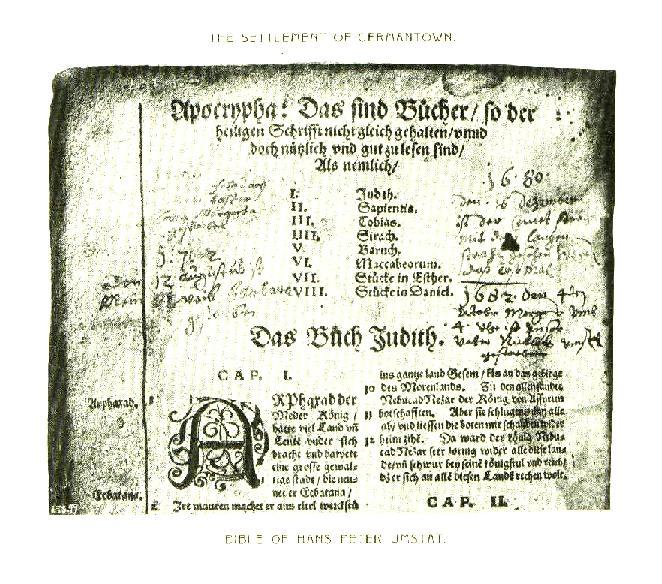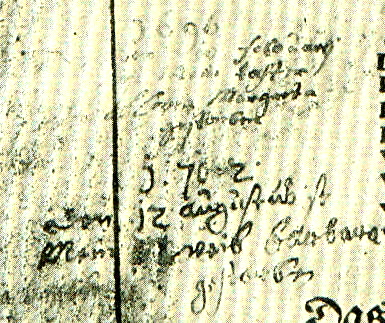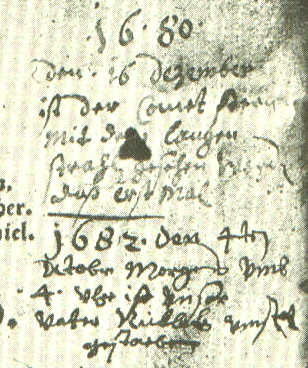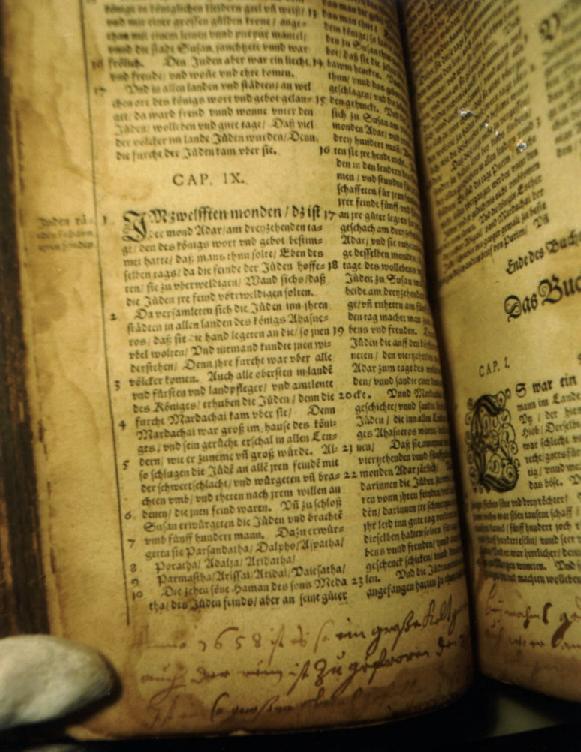Hans Peter Umstatt's
Bible
Hans Peter's Bible has been in the
Pennypacker family for over 300 years, and is currently housed
at Pennypacker Mills in Schwenksville, PA, which now belongs to
Montgomery County.
Ella Aderman of Pennypacker Mills says this about it: "The
title page is not original to the Bible, it is one of the many
pages (actually about 2/3 of the bible) that SWP found from another
like Bible and had combined with what was left of the original
Bible when it was rebound. Our main concern
is that family members understand that it is not available for
general public inspection because of its fragile condition, especially
when the older photographs show more than what can be seen now."
This most important of old photographs, which shows the
major handwritten notations, comes from
Pennypacker's THE SETTLEMENT OF GERMANTOWN and the Beginning
of German Emigration to North America, William J Campbell, Philadelphia,
1899. I have scanned it directly from the book. Other copies making
the rounds come from a publication of the
Pennsylvania German Society and are not as clear.

 |
|
 |
|
1696 den 10 Februarie ist mein tochter Anna
Margretta gestorben |
|
1680 den 16 Dezember ist der Comet stern mit den
langen strahl gesehen worden dass erstinal
|
|
1702 den 12 Augustus ist mein weib Barbara
gestorben |
|
1682 den 4ten
Oktober Morgens umb 4 uhr ist unser Vater Nicholas Umstat gestarben
|
Governor Pennypacker was able to work with
the original of this page over 100 years ago, and presumably it
was clearer than the photo. The above are his transcripts of the
notations. Archaic German words and spellings are often different
than modern German and the handwriting, as you can see, it not
easy to decipher. His transcripts seem to be for the most part
correct or close enough. Nouns that would typically be capitalized
in German are not always capitalized in the handwritten notations.
1696 den 10 Februarie ist mein tochter
Anna Margretta gestorben - 1696
the 10th of February my daughter Anna Margretta died.
1702 den 12 Augustus ist mein weib Barbara gestorben -
1702 the 12th of August my wife Barbara died.
1680 den 16 Dezember ist der Comet stern mit den langen
strahl gesehen worden dass erstinal (das erst[e] mal) - 1680 the 16th of December the comet star with
the long ray/beam was seen the first time.
Pennypacker translated the word Strahl
as tail, which is not incorrect in concept, but literally means
beam or ray. I read the last three words as das erst(e)
mal, which means the first time and does seem to be what was
written. It's also possible that later transcripts of what Pennypacker
actually wrote were misread.
1682 den 4ten Oktober Morgens
umb 4 uhr ist unser Vater Nicholas Umstat gestarben (gestorben)
- 1682 the 4th of October about 4 o'clock in the morning,
our father Nicholas Umstat died. Gestorben is the correct spelling
and I don't see a strong reason to think the original shows an
a instead of an o. This again may actually be a misreading of
Pennypacker's handwriting.
Looking at this clearer photo from Pennypacker's
book, I may change my mind about the wording on Nicholas's death
being "um8" rather than "umb 4 Uhr," as I
stated earlier in Nicholas Original Documents.
There are two possibilities:
The "4" may actually be a
cross (look at the dots on either side of it). A cross is typically
used in German records to show a death. This would explain what
may be "um8," which should only have been "um"
if Nicholas had died at 4 o'clock. On the other hand, they may
have used umb for um way back then. However, there doesn't seem
to be an obvious b in Nicholas Umstat's name as it's written.
In this better photograph though, it
does look like much more like the word is umb than um8. Thinking
about it further, I realize that we've been seeing Hans Peter's
name as UMstatt and UMBstatt, um (or umb) meaning about or around.
The absence of a cross symbol in the two other death notations
may add to the likelihood that the word is actually umb, in which
case Nicholas did die at 4 o'clock in the morning.
It's a tough call. Fortunately, the
time of Nicholas's death is not as critical as the date itself. Unfortunately,
it is impossible at this point to view the original handwritten
notations due to the Bible's having been rebound too tightly in
1877.

"Anne 1658 ist es so [ein] grosse Kalt gewesen dass auch der rein
ist zugefroren den 31 Januarie ist ein so grosser schneh gefallen
das es vier tag geschueien hatt bei mahns gedencken kein schneh
so grosser ist. Auch wo er am diensten gelegen ist gelegen"
(see page 51) - In the year 1658 the cold was so great that
even the Rhine was frozen up. On the 31st of January so great
a snow fell that it continued four days. There was no snow so
great within the memory of man. Even where it was the lightest
it lay ...
COMMENTS
Photo courtesy of Betsy Umstattd. The
"thing" at the bottom left is a gloved thumb holding
the Bible open.
It appears that this notation continues
on the following page, or it may be another one, I can't tell.
Following are additional notations for
which I've not seen photographs. The source is a typed page headed
"Umstadt Bible" from Pennypacker Mills, a section of
which was apparently written by and dated Saml W Pennypacker,
Dec 28th, 1878. The references after each of the following, based
on the wording, are presumably page numbers from the Bible, but
I'm not positive of that. More information from this page can
be found in History of the Bible.
"Johannes Philippus Krill hatt
die Biebel meinen schwager Mathes Wasselet (?) von
darsten hatt mir sie verschrett 1652" (see page 77) - Johannes Philippus Krill gave
the Bible to my brother-in-law Matthias Wasselet [of Darsten/Dorsten].
He gave it to me 1652.
"Dies ist friedens Tex ... weg
pfaltz so geschehen im jahr 1667 den 29 Feb" (See page 47 of the Prophets) - This is a peace
text for the Palatinate in the year 1667 February 29.
COMMENT - As it seems unlikely that
Nicholas would have bothered writing this comment about the Palatinate
(Pfalz) had he lived in Krefeld, I take this as a further
reference to his whereabouts in 1667 - in the Palatinate, if not
precisely in Kriegsheim, although Kriegsheim was part of the Palatinate.
The above translation is not quite complete, I would translate
it: "This is a peace text ... as it happened in the Pfalz
in the year 1667 February 29.
"Dieser vorgezeignenete spruch
ist der Keiser Ferdinand letzier"
(see page 51) - These marked words were the last spoken by Emperor
Ferdinand.
COMMENT - it is extremely difficult
to interpret these notations without being able to see the originals,
but assuming that the word vorgezeignenete is correct, I would
translate it as "previously shown," an adjective describing
Spruch. Spruch in this case may be better translated as ruling.
Thus, I would translate it: This previously shown ruling was Kaiser
(Emporer) Ferdinand's last.
11 Dec 2002
Back to Nicholas Original Docs
Back to Hans Peter Bibliography
Top of Page
Home
Email




